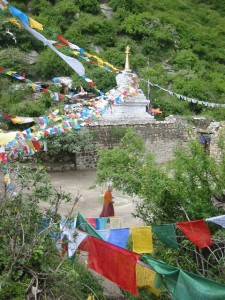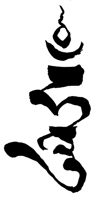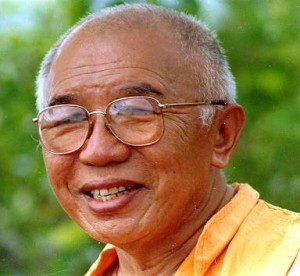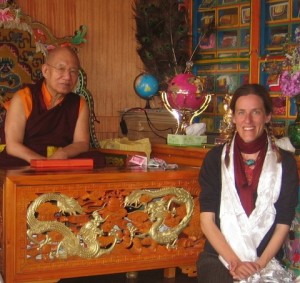Sunday
Featured StoriesFrom Revelation to Lineage: Unveiling Terma
By Holly Gayley
The revelation of terma, or “treasures,” is a distinctive way that new lineages and cycles of teachings are established in Tibetan Buddhism. Since the eleventh century, terma has provided a mechanism for innovation in Tibet, framed as the recovery of ancient wisdom that is accessed through a visionary process.
The one who reveals treasures, known as a terton, acts as a conduit for teachings traced to the distant past—Tibet’s imperial period or, less frequently, the reign of Gesar of Ling—and ultimately to a primordial buddha as its origin point. Tertons are charismatic figures who routinely attract large followings. The most prominent among them have founded new lineages on the basis of their revelations.
Thus revelation and lineage formation are intimately intertwined in Tibet’s treasure tradition.
From Symbol to Text
The first thing said to appear to a terton is a symbol: sometimes a seed syllable, sometimes a line of numinous dakini script. This symbol can appear on a rock, on a scroll, or even in the sky. It provides a mnemonic cue to unlock the memory of a teaching entrusted to the terton in a previous life. The Third Dodrupchen states that the true locus of treasure, even when also hidden in the Tibetan landscape, is the mind of the terton, where it was sealed long ago by Padmasambhava or comparable master.
The decoding of that initial symbol is a visionary process that can take considerable time. The great eighteenth-century terton, Jigme Lingpa, practiced for years in retreat at Samye Chimpu in central Tibet prior to disseminating his famous terma, the Longchen Nyingtik. The symbolic form of the treasures, once decoded, is then rendered into textual form by the terton or a scribe. I was told by the son and lineage holder of a terton in eastern Tibet that his father Dzongter Kunzang Nyima used to dictate several terma at a time to different scribes.
This first textual composition–referred to as the root text of a terma–is only the beginning. The process of systematization involves composing a ngondro, abhisheka, sadhana, and other ancillary practices to form a complete treasure cycle. The terton him- or herself may start this process but it is an ongoing one, sometimes lasting for generations. The terton’s successors, family members or subsequent reincarnations, continue the process of unveiling a terma. The treasure corpus of the Bhutanese terton Pema Lingpa is an apt example of this, whereby several of his incarnations, as well as the late Dudjom Rinpoche some four hundred years later, continued to expand on his corpus.
From Text to Lineage
Terma texts are passed down in a variety of ways. In eastern Tibet, it has been a common practice for tertons to pass their treasure cycles to one or more of their children. This makes sense if you consider that terma is predominantly a Nyingma phenomena and that Nyingma masters frequently marry and transmit their teachings through the family. As a recent example, the treasures of the nineteenth-century terton Chokgyur Lingpa, called the Chokling Tersar, were passed to his sons, Wangchok Dorje and Tsewang Norbu, and through his daughter, Konchok Paldron, to her sons and grandson Tulku Urgyen. What’s more, one of Tulku Urgyen’s sons was recognized as the reincarnation of Chokgyur Lingpa, known as Chokling Rinpoche.
As terma teachings are passed down, lineage forms through two distinct processes. First and foremost, lineage refers to the chain of transmission from master to disciple for a set of teachings. Thus individual treasure cycles, such as the Longchen Nyingtik, have a distinct line of transmission like other tantric teachings. The Longchen Nyingtik was spread widely in eastern Tibet by Jigme Lingpa’s two close disciples, Jigme Gyalwe Nyugu and the First Dodrupchen, Jigme Thrinle Ozer. The latter spawned an incarnation line based at Dodrupchen Monastery in Golok.
In addition, with regard to the entire treasure corpus of a terton, lineage can refer more broadly to the institutional forms that emerge to preserve and propagate it. This can include a monastic seat, reincarnation line, and community who practices together under the terton and his or her successors. As an example of this, the three incarnation lines deriving from Pema Lingpa, each with their own monastic seats, have maintained the teaching stream of his treasure corpus from the fifteenth century up to the present day.
In such examples, one can see how terma is a potent mechanism to establish a new lineage. Fresh and innovative teachings arise with an authoritative pedigree. These teachings proclaim their intended benefit for the very time and place of the terton who reveals them and become the terton’s unique legacy. A thriving spiritual community continues to gather under the stewardship of the terton’s successors. From the visionary process of revelation, an enduring lineage is born.
Further Reading:
Tulku Thondup Rinpoche, Hidden Teachings of Tibet: An Explanation of the Terma Tradition of Tibetan Buddhism (Wisdom Publications, 1986).
Janet Gyatso, Apparitions of the Self: The Secret Autobiographies of a Tibetan Visionary (Princeton University Press, 1998).
Sarah Harding, The Life and Revelations of Pema Lingpa (Snow Lion Publications, 2003).
Tulku Urgyen Rinpoche, Blazing Splendor (Rangjung Yeshe Publications, 2005).
________________________________________
Holly Gayley received her M.A. in Buddhist Studies from Naropa University in 2000 and Ph.D. in Tibetan and Himalayan Studies from Harvard University in 2009. She has done extensive research on the literary and material aspects of terma, culminating in her dissertation on the life and letters of a contemporary terton couple in Golok, Khandro Tare Lhamo and Namtrul Jigme Phuntsok.









Jul 6, 2010
Reply
Thanks for the research and for this posting. Understanding these details as history, as context, and as heritage is so helpful.